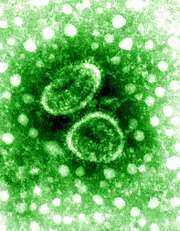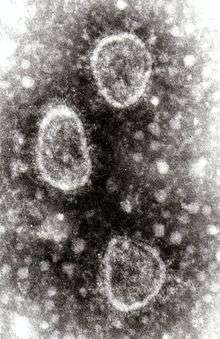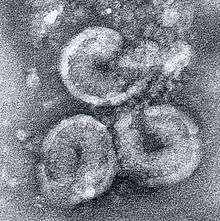Torovirus
| Torovirus | |
|---|---|
 | |
| Virus classification | |
| Group: | Group IV ((+)ssRNA) |
| Order: | Nidovirales |
| Family: | Coronaviridae |
| Subfamily: | Torovirinae |
| Genus: | Torovirus |
| Type species | |
|
Bovine torovirus | |
Torovirus is a genus of viruses in the order Nidovirales, in the family Coronaviridae, in the subfamily Torovirinae.[1] They primarily infect vertebrates.,[2][3] especially human, cattle, pig, and horse.[4] There are currently four species in this genus including the type species Equine torovirus.[1] Diseases associated with this genus include: gastroenteritis,[4] which commonly presents in mammals,[5] but rarely in humans.[6]
Structure
Torovirus particles share characteristics with other members of the family Coronaviridae; they are round, pleomorphic, enveloped viruses about 120 to 140 nm in diameter. The virus particle has surface spikes proteins that are club-shaped and are evenly dispersed over the surface. A nucleocapsid that is doughnut-shaped with helical symmetry is present.[4][7]
| Genus | Structure | Symmetry | Capsid | Genomic arrangement | Genomic segmentation |
|---|---|---|---|---|---|
| Torovirus | Spherical | Helical | Enveloped | Linear | Monopartite |
Life cycle
Viral replication is cytoplasmic. Entry into the host cell is achieved by attachment of the viral S protein (maybe also HE if present) to host receptors, which mediates endocytosis. Replication follows the positive stranded RNA virus replication model. Positive-stranded RNA-virus transcription, using the premature termination model of subgenomic RNA transcription is the method of transcription. Translation takes place by -1 ribosomal frameshifting. Human, cattle, pig, and horse serve as the natural host. Transmission is thought to be via the faecal-oral route.[4]
| Genus | Host details | Tissue tropism | Entry details | Release details | Replication site | Assembly site | Transmission |
|---|---|---|---|---|---|---|---|
| Torovirus | Human; cattle; pig; horse | Epithelium: respiratory; epithelium: enteric | Cell receptor endocytosis | Budding | Cytoplasm | Cytoplasm | Oral-fecal |
Genome
Toroviruses are class IV viruses, and have a single piece of single-stranded, positive-sense RNA. The total length of this is about 28,000 nucleotides and, like all members of the Coronaviridae, toroviruses have a complex replication mechanism that includes the use of subgenomic mRNA, ribosomal frameshifting, and polymerase stuttering.[8]
Taxonomy
Group: ssRNA(+)
- Family: Coronaviridae
- Sub-Family: Torovirinae
- Genus: Torovirus
- Bovine torovirus
- Equine torovirus
- Human torovirus
- Porcine torovirus
Clinical signs and diagnosis
In cattle, the disease causes diarrhoea and systemic signs such as pyrexia, lethargy and anorexia. In calves, it may cause neurological signs and lead to death.
Pigs can be infected without showing any signs.
Diagnosis of the viral infection involves electron microscopy, ELISA or haemagglutination inhibition.
Treatment and control
Supportive treatment may be given to prevent dehydration and secondary infections.
Control relies on good biosecurity measures including prompt isolation and disinfection of premises.
Evolution
Porcine torovirus evolved ~1951.[9] Most of the strains appear to fall into two distinct clades.
History

In 1972, a virus was isolated from a horse in Berne, Switzerland. The virus did not react with antisera against known equine viruses and was shown to have a unique morphology and substructure.[10] In 1982 a similar, unclassified virus was isolated from calves in Breda, Iowa.[11] In 1984 particles resembling these viruses were discovered in the faeces of humans.[12] On the basis of the available information on these viruses, the establishment of a new family of viruses—Toroviridae—was proposed at the 6th International Congress on the Taxonomy of Viruses at Sendai, Japan,[13] but the genus is currently assigned to the subfamily Torovirinae in the family Coronaviridae, order Nidovirales.[2]

References
- 1 2 3 ICTV. "Virus Taxonomy: 2014 Release". Retrieved 15 June 2015.
- 1 2 de Groot RJ, Baker SC, Baric R, Enjuanes L, Gorbalenya AE, Holmes KV, Perlman S, Poon L, Rottier PJ, Talbot PJ, Woo PC, Ziebuhr J (2011). "Family Coronaviridae". In: Ninth Report of the International Committee on Taxonomy of Viruses. (AMQ King, E Lefkowitz, MJ Adams, and EB Carstens, eds), Elsevier, Oxford, pp. 806-828. ISBN 978-0-12-384684-6.
- ↑ de Groot RJ (2007). "Molecular Biology and Evolution of Toroviruses". In: The Nidoviruses. (E.J. Snijder, T. Gallagher and S. Perlman, eds), ASM press, Washington DC, USA, pp. 133-146. ISBN 978-0-387-33012-9.
- 1 2 3 4 "Viral Zone". ExPASy. Retrieved 15 June 2015.
- ↑ Desk Encyclopedia of General Virology. Boston: Academic Press. 2009. p. 507. ISBN 0-12-375146-2.
- ↑ Glass RI, Bresee J, Jiang B, et al. (2001). "Gastroenteritis viruses: an overview". Novartis Found. Symp. Novartis Foundation Symposia. 238: 5–19, discussion 19–25. doi:10.1002/0470846534.ch2. ISBN 978-0-470-84653-7. PMID 11444035.
- ↑ ICTVdB Management (2006). 03.019.0.02. Torovirus. In: ICTVdB - The Universal Virus Database, version 4. Büchen-Osmond, C. (Ed), Columbia University, New York, USA
- ↑ Snijder EJ, Horzinek MC (November 1993). "Toroviruses: replication, evolution and comparison with other members of the coronavirus-like superfamily". J. Gen. Virol. 74 (11): 2305–16. doi:10.1099/0022-1317-74-11-2305. PMID 8245847.
- ↑ Cong Y, Zarlenga DS, Richt JA, Wang X, Wang Y, Suo S, Wang J, Ren Y, Ren X (2013) Evolution and homologous recombination of the hemagglutinin-esterase gene sequences from porcine torovirus. Virus Genes
- ↑ Weiss M, Steck F, Horzinek MC (September 1983). "Purification and partial characterization of a new enveloped RNA virus (Berne virus)". J. Gen. Virol. 64 (9): 1849–58. doi:10.1099/0022-1317-64-9-1849. PMID 6886677. Retrieved 2008-11-23.
- ↑ Woode GN, Reed DE, Runnels PL, Herrig MA, Hill HT (July 1982). "Studies with an unclassified virus isolated from diarrheic calves". Vet. Microbiol. 7 (3): 221–40. doi:10.1016/0378-1135(82)90036-0. PMID 7051518.
- ↑ Beards GM, Hall C, Green J, Flewett TH, Lamouliatte F, Du Pasquier P (May 1984). "An enveloped virus in stools of children and adults with gastroenteritis that resembles the Breda virus of calves". Lancet. 1 (8385): 1050–2. doi:10.1016/S0140-6736(84)91454-5. PMID 6143978.
- ↑ Horzinek MC, Weiss M (October 1984). "Toroviridae: a taxonomic proposal". Zentralblatt für Veterinarmedizin. Reihe B. 31 (9): 649–59. PMID 6393658.
External links
- Toroviruses reviewed and published by Wikivet, accessed 08/10/2011
- Viralzone: Torovirus
- Virus Pathogen Database and Analysis Resource (ViPR): Coronaviridae
- ICTV